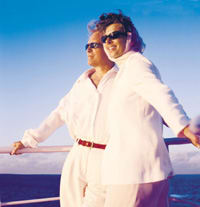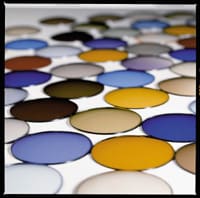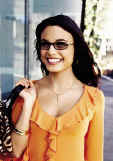|
|
|
|
Photo courtesy of KBco |
FROM THE
VISION COUNCIL
OF AMERICA:
VISUALIZE THIS
Better vision, increased comfort, and enhanced performance--for both work and play--are at your fingertips. Today, eyeglass lens technology has much to offer to complement your lifestyle. This groundbreaking magazine--Lenses & Lifestyles--is designed to help you better understand the options available so you can make the best choice for your vision.
This special publication is sponsored by the Vision Council of America
(VCA) Lens Division and produced by Boucher Communications, Inc. VCA is a non-profit, member- service trade association serving the eyewear and eyecare manufacturing community. VCA works to create awareness of the value of vision care and to grow the eyewear market through education, forums and expositions, industry statistics and data, technical standards, and advocacy.

GETTING STARTED:
The Whole Enchilada
|
|
|
|
Photo courtesy of Rodenstock |
Glasses aren't just about the fashionable frames that look so great on you. Eyeglasses are, in fact, a package that combines the fashion and technology of lenses with the fashion and technology of frames. Together, they create a visual system that's designed just for you and your individual visual and lifestyle needs.
When you talk with your eyecare professional, it's important to consider a variety of factors before determining the frames or lenses that will work best for you.
Common questions: Here are just some of the questions to consider: Is your prescription strong or weak? Do you wear glasses full-time or just for reading? How old are you, and what are your work requirements and leisure activities? For example, do you work at a computer several hours a day, do you spend a lot of time outdoors, or do you participate in specific sports?
Tech talk: The fact is that the last few years have seen tremendous strides in the technology behind both frames and lenses. You want the latest technology in other areas of your life, so why not for the one area that's most important and most visible--your eyes. Ask your eyecare professional about some of the exciting advances, especially in spectacle lenses, and find out for yourself why one pair is not enough.
Beyond the Basics
No, Poly isn't a bird that gets crackers. And PALs don't refer to your best buds. To keep you from feeling up to your eyeballs in tech talk, here is a guide to some of the lens terms you're most likely to hear on a visit to your eyecare professional.
LENS DESIGNS
Aspherics: These lenses have gradually changing non-spherical curves; they feature good vision, a thin profile, light weight, and cosmetic appeal.
Bifocals: This lens has two viewing areas--one for distance and one for near--with a visible line between the two.
Computer Lenses: Near- and mid-range variable focus lenses are good for occupational environments such as computer work. Ask your eyecare professional about other occupational lenses that might be right for you.
Progressive Lenses: Also known as PALs, no-line, or invisible bifocals, these replace the unsightly segment lines of bifocals with a smooth, gradual transition for clear vision up close, far away, and in between.
Single Vision: Single prescription lenses can be for near or far.
|
|
|
|
Photo courtesy of Zeiss Optical |
LENS MATERIALS
CR-39: This plastic lens material is much lighter than glass, but more easily scratched if left uncoated.
Glass: Though heavier than newer materials, glass has outstanding optics and is less susceptible to scratching.
High Index Plastic: Great for strong prescriptions, especially high minus, there are a variety of high index lenses and materials. Because of the ability to bend light more than other materials, high index plastic lenses are lighter and thinner, especially at the edges. Some, like the two below, are also impact resistant.
Polycarbonate: Also called Poly, this is a high-index material that is tough, shatter-resistant, lightweight, and safe for active wearers, home and on-the-job safety, and everyday wear.
Trivex�: This new material is lightweight and good for everyday use, but is also shatter-resistant and safe for active wear.
LENS TREATMENTS
Anti-reflective Coating (AR): This treatment eliminates nearly all reflections from lenses, making them crystal clear and improving both vision and appearance.
Photochromics: These changeable lenses darken outdoors and lighten indoors.
Polarized: Good for outdoor sports and daytime driving, these sunlenses block polarized light that causes the glare that can come from any horizontal surface (from bodies of water to the hood of your car).
Scratch-resistant Coating: It increases durability and resists scratching and abrasion.
Tint: Color treatments can make lenses cosmetically flattering for everyone.
UV Coating: This lens treatment helps protect the eyes against potentially damaging ultraviolet radiation (UVR).
LENS CONDITIONS
Astigmatism: Because of an irregularly shaped cornea, vertical curve is not the same as the horizontal one. The main symptom is blurring.
Hyperopia (farsighted): This means you need vision correction to see up close.
Low Vision: Vision impairments that cannot be corrected by eyeglasses, contact lenses, surgery, or drugs-- problems can range from moderate (e.g., the inability to do daily tasks such as read a newspaper) to severe vision impairment or "legal" blindness.
Myopia (nearsighted): This is the inability to see well at distance.
Presbyopia: A normal process of aging, this is the inability to see up close--it results from the gradual hardening of the eye's lens.
Matching Your Lifestyle Needs
|
|
|
|
Photo courtesy of Rodenstock |
Your lifestyle is varied--from working in the office or home to playing with your children or enjoying outdoor sports. The variety of eyewear options available today can help you shift seamlessly through your day from morning to evening activities. When making an eyewear purchase, it is important to consider your daily routine and any special needs. To help you better understand the options available to you--plus their features and benefits--following is a roundup of specific lifestyle applications where the proper eyewear can make all the difference.
In the Office
There are many lens options to suit a variety of work situations. One of the
most beneficial is computer lenses--for those who spend much of their day tied
to a PC. These lenses can help keep a cap on eye fatigue by reducing glare from
the computer screen and, thus, strain on the eyes. Also, ask about the variety
of lightweight lenses made of higher index materials. They can make a huge
difference in comfort when worn all day long. For example, perhaps you work on
the computer all day at the office and then play a round of golf or tennis in
the evening. Adding AR coating will also assist in reducing glare, and
scratch-resistant coating will increase the life of your eyewear.
Everyday Tasks
Photochromic lenses are ideal for everyday eyewear. These light-sensitive
lenses shift from clear to dark when the wearer steps outside; conversely, they
quickly move from dark to light when indoors. There is no longer a need to
repeatedly juggle eyewear, switching from glasses to everyday sunglasses. They
are perfect for those individuals constantly going in and out of buildings--and
running errands. Another option for those who enjoy spending time outdoors is
having prescription sunglasses tinted and protected against UV rays.
On the Playing Field
When it comes to sports, one of the best eyewear options is polycarbonate.
This lens' impact-resistance will ensure safer vision for your eyes. Scratch
coating is instrumental in protecting your investment while participating in
rigorous activities. Trivex�, a slightly more costly option, offers great
optics as well as impact-resistance and strength for sports from cycling and
golf to baseball and soccer.
Both of these options are also great for kids, who require special protection for their young eyes. According to the Consumer Product Safety Commission, more than 4,700 baseball/softball-related eye injuries resulted in trips to the emergency room in 2000--about 46 percent of them suffered by children 14 and younger. Impact-resistant lenses can guard against injuries such as these.
|
|
|
|
Photo courtesy of Transitions Optical, Inc. |
When it comes to water sports, including fishing and boating, polarized lenses offer the best visual field by reducing glare off the water. Also good for daytime driving, these lenses include a sunglass tint and UV protection, making it a complete package.
The same goes for snow sports. Skiers, snowboarders, and hikers alike will find that polarized lenses will give them an edge in the powder. Again, UV protection is crucial as snow will reflect the sun even stronger, potentially damaging uncovered eyes.
Looking Good
For the fashion conscious, thin and light higher index lenses, especially
those that have increased impact resistance, can ensure an elegant look even for
those with a high prescription. These lenses can also be beveled and polished
for a sophisticated style--and they are ideal for today's popular rimless
eyewear styles. Rimless frames feature an "airy" look because lenses
are mounted to the temples only with tiny drill points. This creates the
illusion of floating lenses.
AR coating is also key for a high-style fashion look as it reduces the amount of glare that bounces off the lenses. Clear, glare-free lenses are aesthetically pleasing.
|
|
|
|
Photo courtesy of Carl Zeiss Optical, Inc. |
Boomers and Beyond
This powerful group includes those at the magic age of 40 and above. Baby
Boomers, technically, are those people born between the years of 1946 and 1964.
As the majority of this group tips into their 40s and 50s, presbyopia (the
inability to see up close) has become a strong reality. The need for reading
glasses, bifocals, or high-tech progressive lenses is a certainty to maintain
visual quality. For reading, people who are presbyopic should definitely ask
about progressive-addition lenses (otherwise known as PALs or no-line bifocals).
Even if you don't need glasses for distance, progressives are more comfortable
and provide better vision than other reading options.
Reading glasses are also an option, but many Boomers anxious to hold onto their youthful looks are opting for the technologically advanced progressive-addition lenses. Aesthetically, PALs are preferable because they feature no prominent telltale line on the lens, like their sister bifocal. From a visual standpoint, they are superior as the strength of the lens changes progressively, not suddenly as with bifocals and trifocals.
|
AGING EYES |
|
Regular eye exams are as important over age 60 as they are before age six. According to Prevent Blindness America, a vision-robbing disease known as age-related macular degeneration (ARMD), which affects the part of the retina responsible for sharp vision, is the most common cause of visual impairment among Americans over age 65. By age 75, reports the National Advisory Eye Council, more than a third of the population suffers from macular degeneration. And even earlier than that--by age 40--15 percent of Americans show signs of the disease. Aging eyes can also benefit visually and aesthetically from UV protection as well as anti-reflective (AR) coating. Sunwear or photochromics with ultraviolet coating are a key defense against the harmful rays of the sun. |
VISION QUEST
The recommendations on this chart will help you get the right lenses for
your lifestyle.
Click on chart below to see larger image
Fashion Front
Face Facts
Face shape is a key factor in selecting the most flattering frames. Overall, it is important to remember three general rules:
1. The frame shape should contrast with the face shape for maximum cosmetic appeal (i.e., if you have a curved face, opt for angular frames and vice versa).
2. The frame size should be to scale with the face size, and the eyes should appear centered in the frame.
3. Eyewear should balance personal proportion. Proportion refers to the size of a face, and the total relationship between sections of the face in proportion to each other.
|
|
||
| FACE SHAPE | GREAT FRAME SHAPES | POOR FRAME SHAPES |
| Square | Oval, round | Geometric |
| Round | Rectangular, geometric | Round |
| Oval | Lucky you...any shape will work! | Small, round |
| Oblong | Wide rectangle, oval | Straight brow bar |
| Heart | Butterfly, rimless |
facial features |
Facial Features
Frame shapes can also help maximize or minimize specific facial features. Here are a few tips:
A long nose: Low, dark, straight bridges shorten the nose.
Close-set eyes: Clear bridges widen close-set eyes.
Wide-set eyes: Dark bridges make wide-set eyes appear closer together.
Strong Rx: Oval shapes and high index lenses help minimize lens thickness.
Long profile: Low temples shorten a long profile.
Short face: High temples lengthen a face.
High forehead: To shorten a high forehead, try a frame that is even with the brow, or slightly higher.
Wide jaws: Wide jaws can be offset by a narrow frame with a pronounced horizontal line.
Narrow face: Decorative or contrasting temples can widen a face.
For more information on the right frame for you, go to www.eyecessorize.com.
Frame Lines
Here are a few general guidelines to help you understand the effect frame shape can have on the way your face looks.
Horizontal Lines...widen
Vertical Lines...lengthen
Curved Lines...soften
Diagonal Lines...flatter and lift
kids korner
Many parents assume that most vision problems don't occur until children start school. They also assume that they would certainly know it if their child had a vision problem. Neither is true, however. Simply put, it is never too early to protect your child's vision.
|
|
|
|
Photo courtesy of Transitions Optical, Inc. |
Protecting Young Eyes
Because the damaging effects of UV are cumulative, protecting your child's eyes--and your own--from the sun is one of the most important things you can do.
- In Australia, even infants wear sunglasses. In the U.S., however, less than eight percent of children who wear prescription glasses also have a pair of sunglasses.
- There are a couple of critical reasons why your children-- whether they need vision correction or not--need to wear sunglasses. First, research recently announced by Transitions Optical reports that 80 percent of a person's lifetime exposure to UV occurs before age 18. And, second, children's eyes are less capable than adults' of filtering harmful UV light. So, make sure your children wear sunglasses outdoors, and, if they already wear prescription glasses, that the lenses are treated with UV coating.
- Sunglasses--a wise second-pair investment--and prescription eyewear should block 100 percent of the harmful portion of UV. Sunglasses are also important throughout the year. Regardless of the temperature outside, the harmful effects of the sun remain powerful.
THE IMPORTANCE OF PRE-SCHOOL EXAMS
Does your child repeatedly rub, squint or blink his or her eyes? Hold reading materials too close? Avoid close work? Use a finger to follow lines? Turn his head to read? Complain of headaches, blurred vision, or burning eyes? Mix up similar words or letters? If the answer to any of these is yes, a comprehensive eye exam is necessary.
|
|
|
|
Photo courtesy of Transitions Optical, Inc. |
The Vision Council of America has created the "Check Yearly. See Clearly." campaign. Since its inception in 2001, "Check Yearly. See Clearly." has garnered the support of over 10,000 eyecare professionals. One of the campaign's key messages is the importance of children receiving a comprehensive eye exam before starting school.
Why? One in four children in the U.S. has an undiagnosed vision problem. Undetected vision problems that can interfere with learning include astigmatism, hyperopia, convergence, lazy eye (amblyopia), and even low vision (problems that cannot be corrected with conventional eyeglasses, contacts, surgery, or medicine).
So, what about vision screenings? According to results of recent research, a simple vision screening--commonly given by a pediatrician or a school nurse--detects only 5 percent of all vision problems. This is upsetting considering nearly 80 percent of what a child learns is obtained visually in their first 12 years. The Vision Council of America recommends a regular comprehensive eye exam beginning at age three if no visual problems are evidenced beforehand.
If you'd like to learn more about vision health, please visit www.checkyearly.com.
Sight Bites
|
|
|
|
Photo courtesy of Pentax |
CONTACTS AND SUNWEAR
More than 50 percent of new contact lens wearers have traditionally bought sunglasses within weeks of purchasing their lenses. Why? Whether it's due to reflections from the edges of the lenses or increased transmission of light when contacts are worn, some wearers report their eyes seem more sensitive to light when wearing the contacts. The key is to buy quality sunglasses that offer 100 percent protection from both UVA and UVB (the light that causes sunburn and skin cancer) rays.
|
|
|
|
Photo courtesy of Rodenstock |
Vision in Hindsight
59 A.D.: Nero is seen at the Coliseum looking through green lenses cut from emeralds.
1252: The portrait of an Italian bishop represents the earliest recorded image of a person wearing glasses. It can still be seen at a church near Venice.
1500: Leonardo da Vinci writes about and sketches what today are called contact lenses.
1784: Ben Franklin invents bifocals.
1850: Abe Lincoln pays 371/2 cents for his first pair of spectacles.
1942: General Douglas MacArthur is rarely seen without what quickly become the world's best-known sunglasses. Designed for WWII flyers, that still-popular style is aptly called "aviators."
Photos courtesy of (clockwise from top right) Pentax, Rodenstock, and Carl Zeiss Optical, Inc.
|
|
|
|
Photo courtesy of Carl Zeiss Optical, Inc. |
TANTALIZING TINTS
One of the easiest ways to zip up your eyewear wardrobe is through lens tints. Stars of the silver screen and rock icons alike have embraced the trend of wearing colorful tints on prescription and just-for-fun eyewear--as well as dark hues in sunwear. A rainbow of colors is available--the hottest picks include light shades of pink, blue, and yellow. For an added edge, flash mirror coatings can be applied over colors or even clear lenses. Tints are also an advantage when it comes to sports sunwear. Look for sports-specific colors (such as light brown for golf) that can help you better spot the ball, the green, or the trail.
Ready Readers
So, what's the difference between $20 readers at the drugstore and the more expensive options available from your eyecare professional? It's one word--optics. Among other things, most people don't have the same prescription in both eyes or the same optical center as everyone else, and "one-size-fits-all readers" don't take this into account. Also, many inexpensive readers don't have ophthalmic quality lenses, and the resulting distortion and limited field of view can cause headaches and eye fatigue. There are well-made readers, however. They often come in handy as an extra pair, and your eyecare professional may even carry some. Don't forget "from the rack" is never a substitute for an eye exam. Not only do eye exams determine your need for vision correction; they can also uncover a number of other health problems such as glaucoma, hypertension, and diabetes.
To receive additional copies of
Lenses & Lifestyles, please contact VCA at lenses@visionsite.org.

















